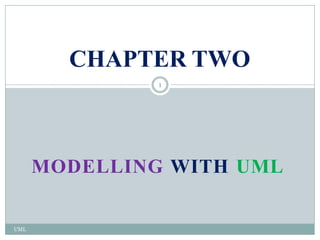The document provides an overview of the Unified Modeling Language (UML). It discusses UML's building blocks including elements, relationships, and diagrams. It describes the different types of UML diagrams including use case diagrams, class diagrams, sequence diagrams, activity diagrams, and deployment diagrams. The document focuses on use case diagrams, explaining what use cases and actors are, and how to identify them.
















































































![Class Diagram
81
ClassAttributes
Attributes (fields, instance variables)
visibility name : type [count] = default value
Visibility of Attributes can be:
+ public
# protected
- private
/ derived
UML](https://image.slidesharecdn.com/chapter2-220502123610/85/Chapter-2-pptx-81-320.jpg)





















![Sequence Diagram
103
member:
LibraryMember
book:Book
:Book
Copy
borrow(book)
ok = mayBorrow()
[ok] borrow(member)
setTaken(member)
Sequence Diagrams](https://image.slidesharecdn.com/chapter2-220502123610/85/Chapter-2-pptx-103-320.jpg)
![Sequence Diagram
104
member:
LibraryMember
book:Book
:Book
Copy
borrow(book)
ok = mayBorrow()
[ok] borrow(member)
setTaken(member)
X-Axis (objects)
Y-Axis
(time)
Object
Life
Line
message
Activation
box
condition
Sequence Diagrams](https://image.slidesharecdn.com/chapter2-220502123610/85/Chapter-2-pptx-104-320.jpg)





![Collaboration Diagram
UML
110
🟆 Components of collaboration diagram
Named objects
Links: by a continuous line between objects, and indicates the
exchange of messages
Messages has following attributes
Synchronization --thread name, step within thread.
Sequence number
Message labels : Message names may have the arguments and return values.
*[iteration]. It uses decimal notation.
Message direction.](https://image.slidesharecdn.com/chapter2-220502123610/85/Chapter-2-pptx-110-320.jpg)








